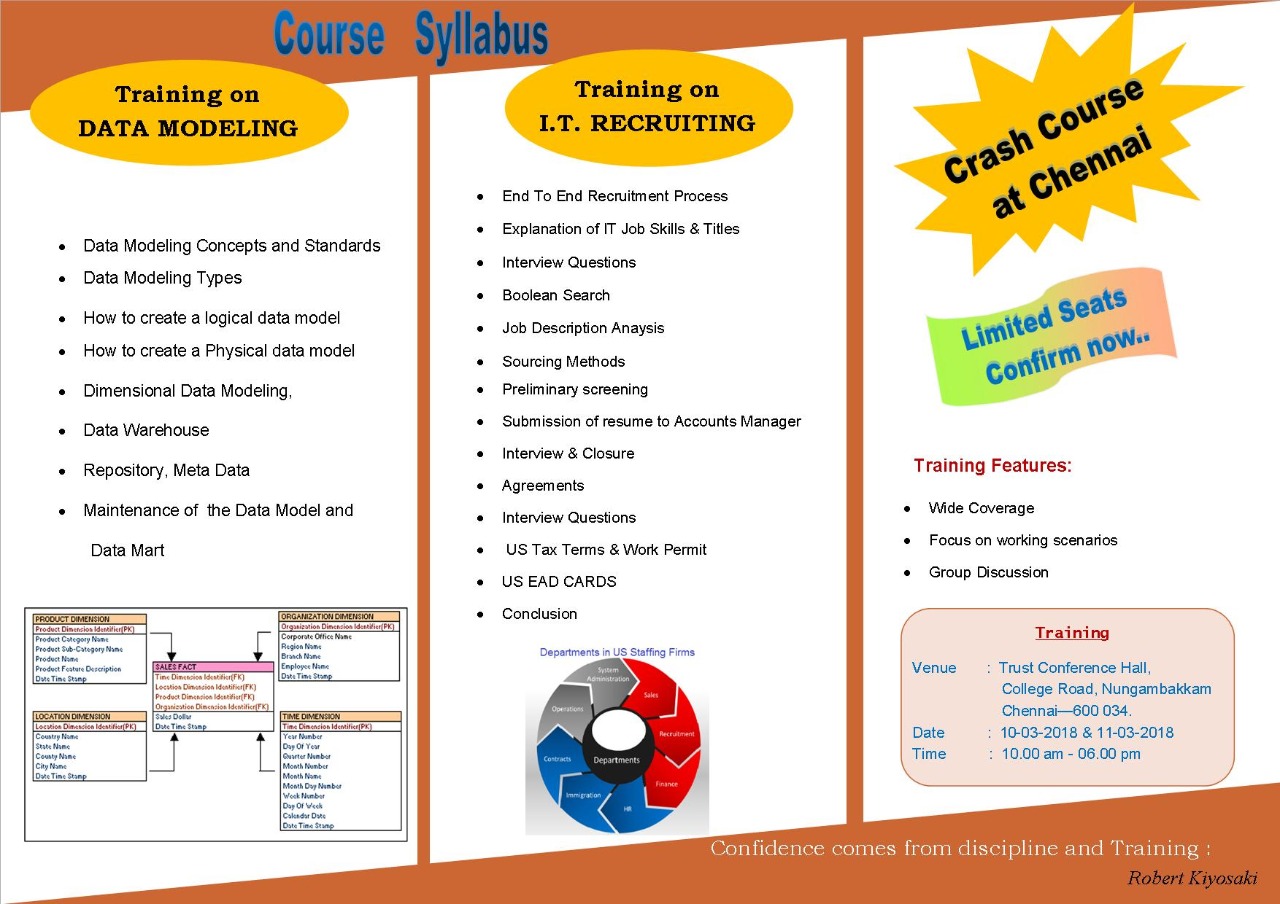Crash Course on Data Modeling Training using ERWIN Tool
Course Description:
This training course explains in detail about database, data warehouse, data modeling concepts, data modeling types and how these are used in OLTP environments and Data warehouse / Datamart Environments using Erwin, Power Designer & Oracle SQL Data Modeler.
To get more information about this training program, send an email to Training@LearnDataModeling.Com 0r call us @ 91-9884675745.
Course Brochure:
Course Syllabus
Part 1 – Career Path of a Data Modeler
- What is a Data Modeling?
- Explanation of Data Modeler duties in brief
- Certifications in Data Modeling
- Career Path of a Data Modeler
- Salary of a Data Modeler
Part 2 – Data Modeling Concepts
- Who is a data modeler?
- What are the other alternative titles for a Data Modeler?
- What are the duties and responsibilities of a Data Modeler?
- What is the difference between duty and responsibility?
- What is a Data Model?
- Who needs Data Modeling?
- Different Data Modeling Tools
- IDEF1X and IE Methodology
Part 3 – Data Modeling Types
- Logical Data Model
- Physical Data Model
- Dimensional Data Model
- Conceptual Data Model
- Enterprise Data Model
- Data Modeling Development Life Cycle
Part 4– Data Model Standards
- Naming standards of objects
- Abbreviating column names
- Consistency in Column Names
- Why it is important
Part 5 – Database Explanation from Data Modeling Perspective
- Main object: Table, Column, Datatype
- Constraints: NULL, NOT NULL, Primary Key, Unique, Check, Default Value
- Other objects: Database, Schema, Tablespace, Segment, Extent, Privileges, Index, View, Synonym
- DDL Statements: CREATE, ALTER, DROP
- DML Statements: INSERT, UPDATE, DELETE
Part 6– How to create a logical Data Model
- Entity, Attribute, Primary Key, Alternate Key, Inversion Key Entry, Rule, Relationship, Definition, Index, Unique Index
Part 7– Relationships
- Identifying, Non-Identifying, Many to Many
- Cardinality
- One to One Relationship
- One to many relationship
- Many to many relationship
- Whether Zero option is required or not
- Resolving Many to Many Relationship
- Self-Referential Integrity Relationship
- Normalization process
- Supertypes and Subtypes
Part 8 – How to create a Physical data model:
- Table, Column
- Primary Key Constraint, Unique Constraint Check Constraint, Foreign Key Constraint, Comment
- Default Value
- Unique Index, Non-Unique Index,
- Difference between a logical data model and Physical Data Model
Part 9 – Physical Data Model, Database & Scripts:
- What is Forward Engineering?
- How to generate scripts from a data model and share it with DBA?
- What is Reverse Engineering?
- How to create a data model from a database?
- How to create a data model from a script?
- How to compare data models?
- How to compare database and a data model?
- What is subject area?
- Why do we need so many subject areas?
- How to implement Physical data model in a database?
- How to generate SQL Code?
- How to implement it in Database?
Part 10 – Concepts: Dimensional Data Modeling, Data Warehouse and Data Mart
- What is a Lookup?
- How to maintain data in Lookups?
- What is a Data Warehouse?
- What is a Data Mart?
- What is a Dimension?
- What is Snow Flake Modeling?
- What is Star Schema Modeling?
- What is Slowly Changing Dimensions?
- What is Dimensional Data Modeling?
- How to create a data model for Data Warehouse and Data Mart?
Data Modeling Demo Videos:
- 01 Data Modeling Development Life Cycle
- 02 Data Warehouse Training – Table & PK
- 03 Simple Select Statement and Alter Statements
- 04 Data Warehouse Training ETL Tools
- 05 Data Warehouse Training Normalization
- 06 Data Warehouse Training – Cardinality and Optionality


